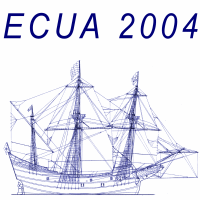

S.M. Jesus, C.Soares, A. Silva sjesus@ualg.pt , csoares@ualg.pt and asilva@ualg.pt
SiPLAB-FCT, Universidade do Algarve
Faro, Portugal
E. Coelho coelho@nurc.nato.int
NATO Undersea Research Centre
La Spezia, Italy
Comments: download pdf file
Ref.: Proc. of ECUA' 2004,
(ISBN:90-5986-079-9), p.271-279, Delft (The Netherlands), June 2004.
Abstract : Rapid Environmental Assessment (REA) is a goal to
which
acoustics
can give a significant contribution. That contribution can be cast as
the
result of the inversion of ocean acoustic properties from the
propagation
of acoustic signals. Traditional ocean tomography systems and methods
for
their requirements of long and well populated receiving arrays and
precise
knowledge of the source/receiver geometries are not well adapted to
Acoustic
REA (AREA). An innovative concept to respond to the AREA requirements
is being
proposed as an integration between a network of sophisticated
Acoustic-Oceanographic
Buoys (AOB) and algorithms for online ocean properties inversion. A
prototype
of the system, including one sonobuoy and a preliminary version of the
inversion
code, was tested at sea during the Maritime Rapid Environment
Assessment'2003
sea trial (MREA'03) and is described in this paper together with the
results
obtained. The AOB is a light acoustic receiving device that
incorporates last
generation technology for acquiring, storing and processing acoustic
and
non-acoustic signals received in various channels along a vertical line
array.
The physical characteristics of the AOB, in terms of size, weight and
autonomy,
will tend to those of a standard sonobuoy, with however the capability
of
local data storage, processing and online transmission. During the
MREA'03
the AOB was deployed at two occasions, during several hours, on a free
drifting
configuration. Source/receiver geometry was estimated from the on
the
buoy GPS, that served also to precisely time mark the acoustic signals.
On
line processing was made possible by wireless transfer of the data and
inversion
in a complex range-dependent environment. Temperature profiles inverted
from
acoustic signals in two frequency bands on near real time are shown to
approximately
agree with concurrent CTD measurements.
ACKNOWLEDGMENT: this work was partially supported by FUP/Ministry of Defence program under project LOCAPASS and AOB - REA Joint Research Project.